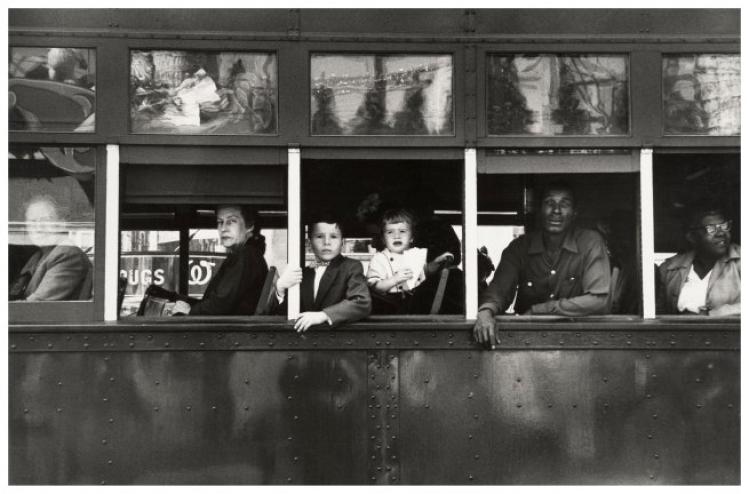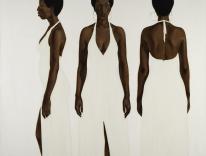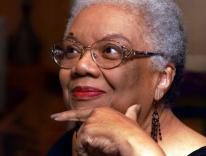
At twenty, most of us have painfully learned that stereotypes are a way of lying, of expressing the sprawl of reality, the contradictions of experience. By thirty, we discover the other side of the coin: that the stereotype is a way of saying a half-truth. To be sure, people and things are frozen, plucked out of time and history in the process, but there is always a wisdom at the center of the distortion.
When it comes to stereotypes of America, there is even more complexity, for all of them are partially true, even though many of them express polar opposites. Dickens' vision of revolutionists devoted to freedom and slavery is accurate; Blake's prophetic image of a liberating nation is too. More recently, the fashionable stereotype has been almost completely negative. "America" stands for gadgetry, rootlessness, in the tyranny of mass-produced kitsch. "Americanization" is the terrible fate which is befalling Europe as it produces an efficient industrial civilization. The symbol of Coca-Cola shall stand over all.
Another America is suggested by Robert Frank in his brilliant collection of photographs, The Americans. He has seen a nation of almost tragic spaciousness in which people are glimpsed at a moment of repose: looking out of windows, listening to music, sometimes thoughtful but always waiting, caught in a welter of experience (or, to make the metaphor photographic: riding an endless highway). His camera has defined an older stereotype, one which precedes the theories of mass culture and says the exact opposite of the grim thesis that posits "Americanization" as mechanized mindlessness.
In The Americans, one finds two main vantage points: the region and the working people. It is important to remember (or to be reminded) that families need not look as serenely vulgar as they do in a Norman Rockwell illustration, that there are still faces clearly marked by their experience, areas which defy any attempt to erect a huge stereotype. And people still work. The middle-class citizen, so distant from the plant and perhaps hypnotized by automation, can almost come to believe that the commodities of this society are produced invisibly and without human intervention. Frank's camera reminds one that this is not so. For there is an America which has perhaps been out of sight in the fifties. A feeling of helplessness, of frustration in a decade of conservativism and reaction, directed the eyes toward the neon sign and the infinite rows of Coke bottles. But another America remained. It is, to be sure, under the attack of mass culture and it may be destroyed by the incredible incompetence of political leaders. As of now, it survives.
The most obvious, even defining, fact about the other America is its variety, the resourcefulness of its geography. One million sign-boards can be erected on the highways; hundreds of thousands of vistas can be blocked out of view; but a sweeping magnificence persists.
In Seattle, Washington, the people live in the presence of Mount Rainier. The Indians, it is said, once thought that this solemn peak was God. Their mistake is understandable. Driving in the city, one never knows when the turning of a corner will reveal the aspect of beauty. On a clear day, each hour, each period, is given a special definition by the mountain. And this geography enters into a culture. It is, of course, intermingled with the history of the region: logging, the I.W.W., the Seattle General Strike of 1919 (in this American city, they spoke of "Soviets" at that time), the weather-beaten and brawling tradition of a port.
Thus, the coffee cups in many restaurants in Washington are bigger than they are in the East. Their shape developed out of an outdoor, working world and they are part of the texture of life in the area. At the trucker's stop in the Cascade mountains where breakfast is ten strips of bacon, four eggs and a pile of home-fries, these coffee cups are one of the forms defining a history and a way of living. They are related to the towering fact of the mountain.
Then there is a place like Stockton, California. This is the center of a lush, profitable farm land which for years has been dominated by huge growers. In the city, one suddenly confronts an unusual sight in contemporary America: a working class defined by its clothes. Someone remarked not too long ago that when the big factories in Detroit put up lockers for the workers, the existence of social classes became harder to see on the city streets. The men no longer went to the shop in their work clothes. Rather, they wore clean shirts and slacks and changed at the plant. This hasn't happened yet in Stockton.
As you drive through the city, the sun-burned faces of the lounging men along skid-row (where the "shape up" for the farm workers takes place early in the morning) are unmistakable. Every field-hand wears a hat; the Levis ride low on the hips. The impression is utterly unlike that of a mid-Western farm town, for it is dominated by day-laborers and not by farmers. And yet, even here, there is a participation in the romance of the métier, the miserable, low-paid, starvation métier: "Picking gets in the blood," a serious face will say. "I've been trying to quit for twelve years, but I'm still here."
And there is an industrial geography, too. Outside of Pittsburgh, there are coal and steel towns with their slag heaps, their company houses, the perpetual shadow of the machine. Yet, when the plant gives out (as the mines in West Virginia have), the people cling to their tiny, dirty world. There are friendships, churches, traditions, a fierce way of life within the great world. Here, as in Seattle or Stockton, the region has made a culture. Even here.
One could go on and on, but the point is obvious. The other America is still a nation of regions, of scenic surprise (as the plane lifts over the mountains coming down from Denver, the city of Albuquerque and the desert on which it lies seem almost a Shangri-la). The other America is culturally heterogeneous: its coffee cups are different, so are its politics. Its vitality may well be a matter of cultural lag, of a historic impetus acquired in experiences which pre-date the era of mass culture. But the other America is real.
And yet there is a point of homogeneity. At its worst, it is a source of arrogant ignorance and bigotry; at its best, it is the persistence of something precious and fine. The other America is not simply a political democracy. It is a democratic culture as well. Not too long ago, Dwight Macdonald wrote of America in Dissent:
Here: everybody’s ‘equal’ in the sense that nobody respects anybody else unless he has to, by force majeure; the national motto should be not ‘E Pluribus Unum,’ not ‘In God We Trust,’ but ‘I got mine and screw you, Jack!’ or better, ‘Brother’— (‘friend’ and ‘brother’ being used to express extreme hostility and contempt).
Macdonald is quite right, quite fashionable and quite wrong. Our democratic culture has led to anti-intellectualism, to an incredible egotism, and it lacks a European respect for tradition. All this is true, but this stereotype must have its counter stereotype: the positive, driving force of the egalitarian ethos in the United States.
Take waiters. At the point of table service, a culture expresses its values profoundly. The English waiter "thanks" the patron at every moment in the process. There is a litany of servility. The German customer will call the lowliest bus boy "Mr. Headwaiter," but accompanies this by an imperiousness of the voice and, often enough, table pounding. The tone contradicts the form. And in America, waiters are often gallingly independent, slow, poised and familiar; yet they are not overwhelmed by being waiters, they are as "good" as you are.
On another level, there are thousands of union locals in the other America where workers participate in a living democracy. This is the "other" labor movement (other than the one-sided, and often malicious, image of the union produced in the Congressional hearings). In it, local presidents are regularly defeated for office, the rank and file produces its own leaders and a sense of solidarity is real and alive. A famous European socialist once said to a friend of mine, "Your workers walk differently. They seem so confident."
In such an atmosphere, "Brother" is not a word of contempt but a token of a certain community. At times, it is even embarrassing to hear. Not long ago, a rank-and-file unionist in Lansing, Michigan, who had been on the losing side in an election, was shocked at the idea that this should lead him to distrust the union itself. His victorious opponent, he explained to me, was a union brother and despite their differences they were part of a common cause. The moment was, to be sure, sentimental (and, consequently, for the observer, not without its irony), but it happens in the other America.
All of this, of course, is not the product of some mysterious, genetic process whereby Americans were born different—or better. It comes out of our history. The frontier, the immigrant waves, the tradition of opportunity, the struggle of Populist farmers and C.I.O. workers—these are the creative moments of a democratic culture. They have not marked America with those ruins and layers of civilization which make the European tradition so visual. True enough, the other America is constantly tearing down buildings and putting up taller ones. But the continuity does exist in the manners, attitudes and speech of the people, and this is another sense of the word America.
Perhaps what confuses so many people about the other America is that it is a maze of contradictions. The sense of solidarity can also become xenophobia; the egalitarianism can turn savagely on the representative of high culture. Or, by a peculiar paradox, the American sense of classlessness often becomes a support for the reality of social classes. It conceals antagonisms, it blunts the drive for social justice; the belief that we are "all" middle class is part of a mechanism of domination in which the people are submissive.
Yet these contradictions are but another expression of the expansiveness, the individuality of the other America. And taking the positive stereotype rather than the negative, this American egalitarianism is a more decent and human way of people meeting people than exists in societies which have impressive monuments to tradition. Indeed, this is probably the American monument.
It is important to understand the other America. For if the pessimistic theorists are right, we live in a nation which has been artificially homogenized, and where opinion is infinitely manipulable. That is the pejorative sense of America, and it expresses its own truth. But the inescapable conclusion of such a vision is, at best, the attitude of the benevolent bureaucrat (if only the "good" people could get hold of the means of brainwashing, and manipulate the masses for a "good" cause). On the other hand, there is hope if one can see the other America. Take the Negroes in the Southern sit-ins for an example.
For some years, a great many Negroes in the South conformed to part of the racist stereotype. They were passive, they accepted their own degradation. This was accomplished through a political mechanism of terror, an economic system of harsh exploitation, a social reality of exclusion from the culture of the white man. But even then, the other Negro was developing. First of all, there was the enormous creativity which went into the Negro Church. (To some, this seemed only quaint; in retrospect, it must be recognized that this was a momentous fact.) Then there came the slow contact with a broader world-with the radio, movies, television, the unions and modem industry. Behind the stereotype, a new tradition was in the making. It burst out in the Montgomery bus-boycott; it subsided; it has flared up, all the stronger, in sit-ins.
And what if this would happen, not only among the Negroes, but throughout the other America as well? The future, if it is to contain hope, is being prepared in the midst of the other America. Here, in that part of the nation which is not dominated by gadgets and mass media, is the source of our creativity. This sentiment, in its gutted form, is the commonplace piety of all the candidates and Fourth of July orators who have ever been. But it may be the expression of a reality, too; the reality of the other America.
Please email comments to [email protected] and join the conversation on our Facebook page.
Share
Previous Story
Pilgrimage to Mexico
Next Story
Labor, Management and the Public

